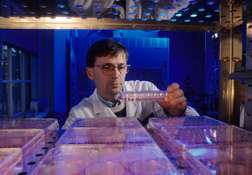Better Beans Mean Better Health for All

(PhysOrg.com) -- Beans that add pleasing tastes and textures to chili, soups, and other favorite dishes may tomorrow be an even better source of an essential nutrient -- iron. That's a goal of Agricultural Research Service (ARS) physiologist Raymond P. Glahn. His studies may help plant breeders develop new and improved beans.
Glahn, based at the ARS Robert W. Holley Center for Agriculture and Health on the Cornell University campus at Ithaca, N.Y., collaborates in the research with Elad Tako, an ARS research associate; Michael A. Rutzke, a Cornell University analytical chemist; and others.
Their research would especially benefit the more than two billion people worldwide who are iron-deficient.
Some of the Ithaca investigations are designed to determine how plant breeders and others might boost beans' iron bioavailability—the amount of iron that the body can absorb and use from beans.
To discover more about the availability of iron in beans, or in other foods and food components, Glahn developed a laboratory test in 1998 that uses Caco-2 (pronounced KAY coe) human intestinal cells. The test gives an indication of how the human digestive system would treat beans and nutrients from beans.
Lab animal tests, conducted as a follow-up to some Caco-2 assays, are an important intermediate step between Caco-2 tests and costly studies with human volunteers, according to Glahn. In recent years, tests conducted by Glahn and co-researchers at Ithaca suggest that chickens have promise as an animal model for iron-absorption studies.
In an article published earlier this year in Poultry Science, Glahn and co-investigators report that chickens are sensitive to iron deficiency, and that at least a half-dozen different indicators of this deficiency, already used in studies with other animals, are valid for research with chickens, as well.
In other work, Glahn's team found that results from their iron bioavailability tests with chickens confirmed a Caco-2 finding: iron in red beans was less bioavailable to the animals than was iron in white beans.
Provided by USDA Agricultural Research Service



















